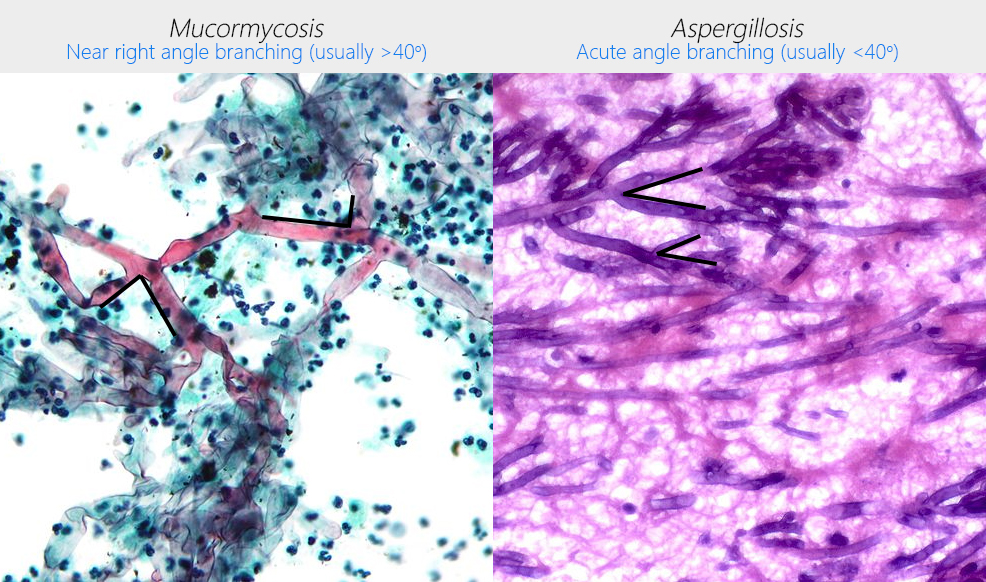WBR0187
Jump to navigation
Jump to search
| Author | [[PageAuthor::Ogheneochuko Ajari, MB.BS, MS [1], Serge Korjian M.D. (Reviewed by Serge Korjian)]] |
|---|---|
| Exam Type | ExamType::USMLE Step 1 |
| Main Category | MainCategory::Microbiology |
| Sub Category | SubCategory::Infectious Disease |
| Prompt | [[Prompt::A 42-year-old man with history significant for poorly controlled diabetes mellitus presents to the emergency department with a 2-day history of fever, headache, and facial swelling. Following an extensive work-up, a nasal biopsy frozen section reveals necrotic tissue with irregularly wide, non-septate hyphae branching at right angles. What is the most likely causative agent of this patient’s condition?]] |
| Answer A | AnswerA::''Candida albicans'' |
| Answer A Explanation | AnswerAExp::''Candida albicans'' is a dimorphic fungus that characteristically forms pseudohyphae and budding yeasts at 25°C and germ tubes at 37°C. |
| Answer B | AnswerB::''Aspergillus fumigatus'' |
| Answer B Explanation | [[AnswerBExp::Aspergillus fumigatus is a monomorphic filamentous fungus that has dichotomously branching septate hyphae at acute angles usually <40°.]] |
| Answer C | AnswerC::''Blastomyces dermatitidis'' |
| Answer C Explanation | AnswerCExp::''Blastomyces dermatitidis'' forms hyphae with nondescript conidia. The tissue form is a broad-based budding yeast. |
| Answer D | AnswerD::''Rhizopus microsporus'' |
| Answer D Explanation | AnswerDExp::''Rhizopus microsporus'' is on species responsible for mucormycosis. Similar to most zygomycetes it forms broad ribbon-like nonseptate hyphae frequently branching at near right degree angles. |
| Answer E | AnswerE::''Sporothrix schenckii'' |
| Answer E Explanation | AnswerEExp::''Sporothrix schenckii'' is a dimorphic fungus that forms cigar-shaped yeast in tissue. At 25°C it forms septate hyphae with oval-shaped, glass-like spores. |
| Right Answer | RightAnswer::D |
| Explanation | [[Explanation::Mucormycosis (also commonly known as zygomycosis) is an opportunistic fungal infection caused by fungi in the order Mucorales classically of the genus Mucor, Rhizopus, or Absidia. While healthy individuals are resistant to invasive disease, immunocompromised patients particularly those with diabetes mellitus, neutropenia, and immunosuppression following transplantation are at higher risk to develop angioinvasive forms of mucormycosis. Sinoorbital and rhinocerebral forms are classically seen among poorly controlled diabetics. Generally, zygomycetes form irregularly wide (varying between 6 and 50 μm) nonseptate hyphae with frequent right-angle branching. Diagnosis is by tissue biopsy demonstrating the fungal hyphae in necrotic tissue by H&E or special fungal stains. Rhinocerebral mucormycosis carries high rates of mortality and is often complicated by cerebral infarcts due to mycotic emboli if not treated aggressively.
|
| Approved | Approved::Yes |
| Keyword | WBRKeyword::Rhizopus, WBRKeyword::Mucor, WBRKeyword::Mucormycosis, WBRKeyword::Zygomycosis, WBRKeyword::Zygomycetes, WBRKeyword::Fungi, WBRKeyword::Opportunistic infection, WBRKeyword::Immunocompromised, WBRKeyword::Diabetic, WBRKeyword::Dimorphic fingi, WBRKeyword::Fungal infection |
| Linked Question | Linked:: |
| Order in Linked Questions | LinkedOrder:: |
